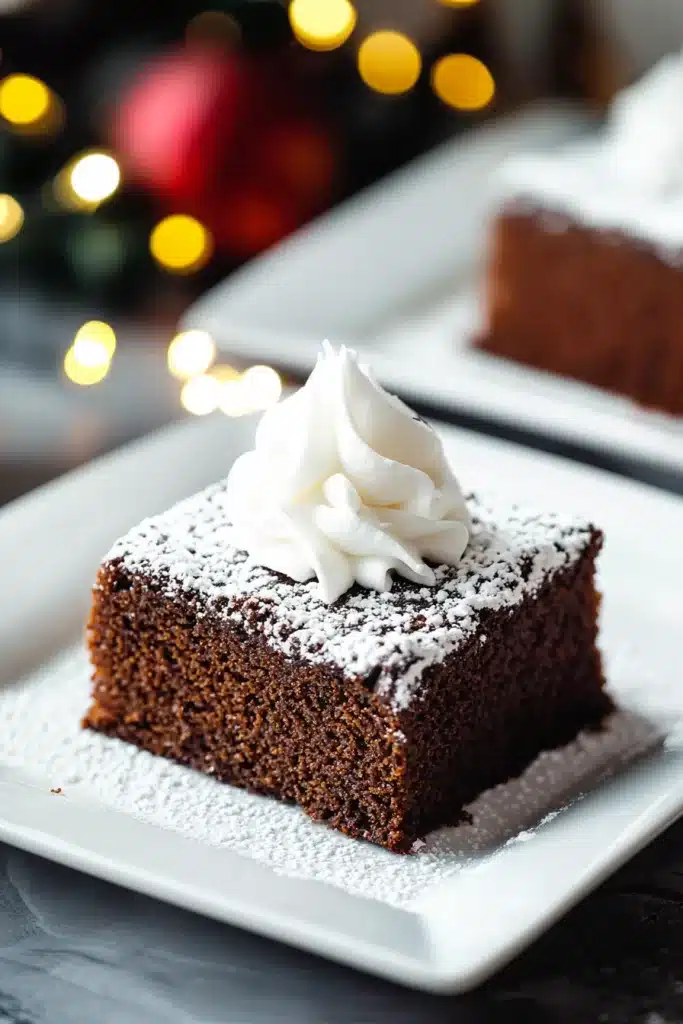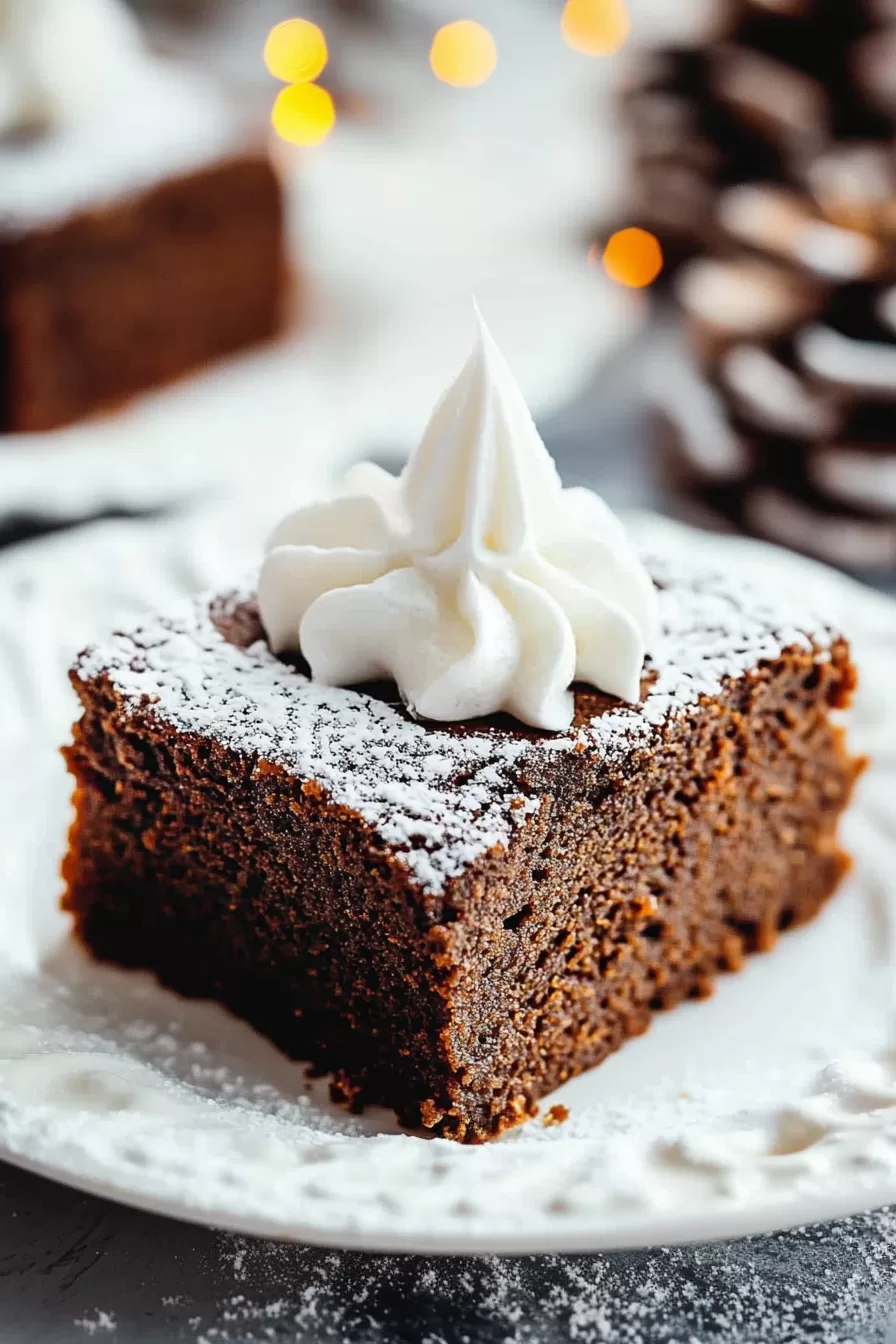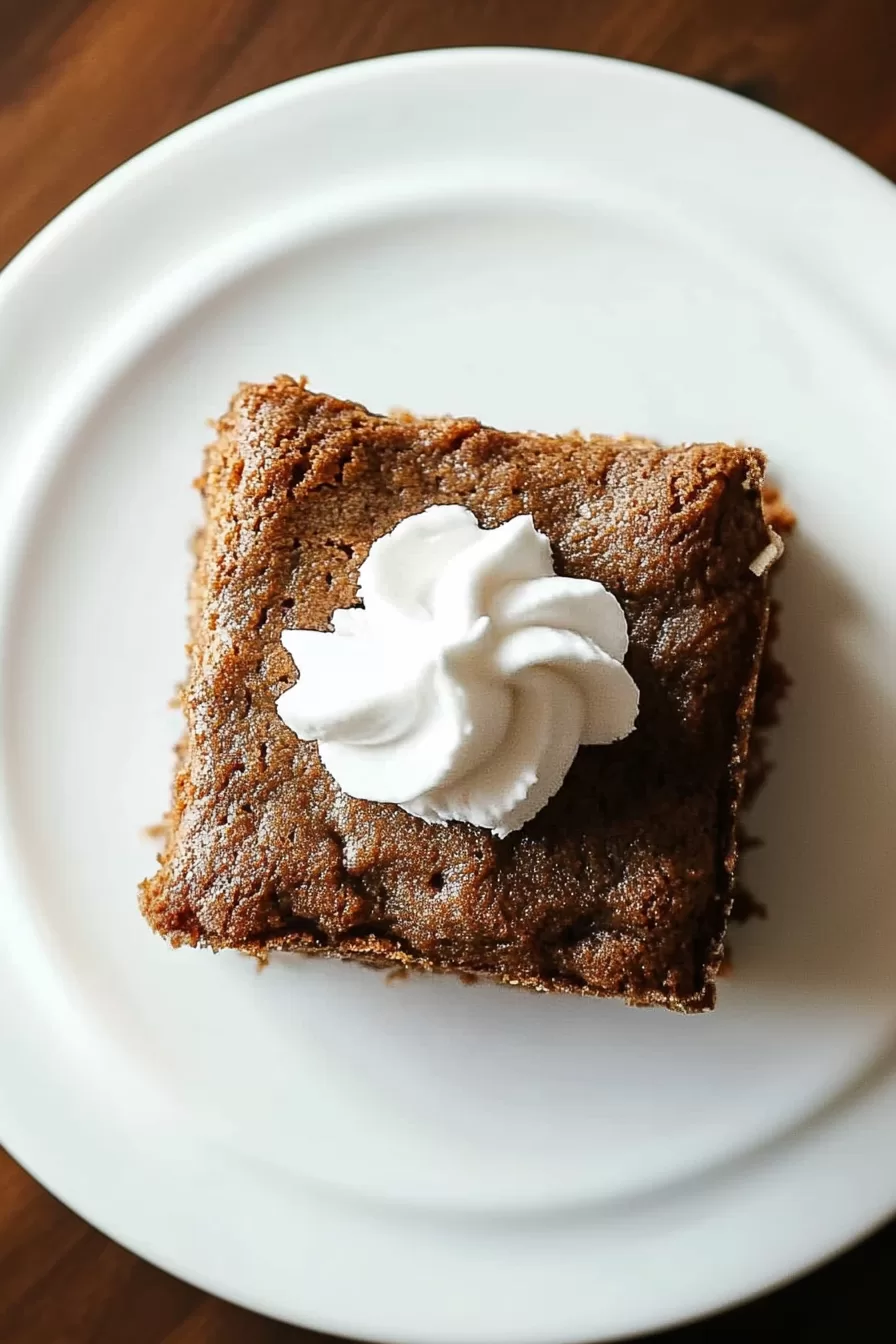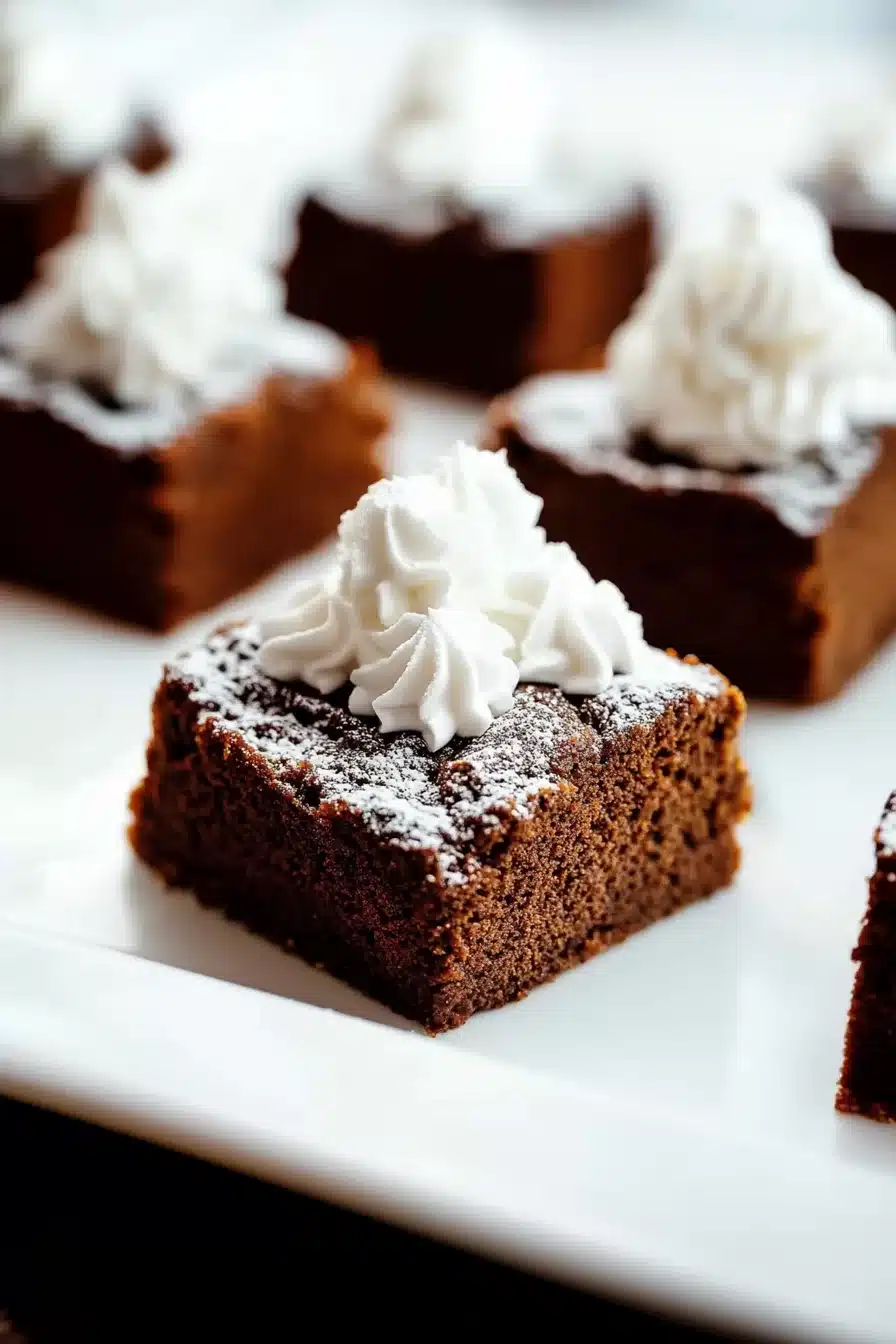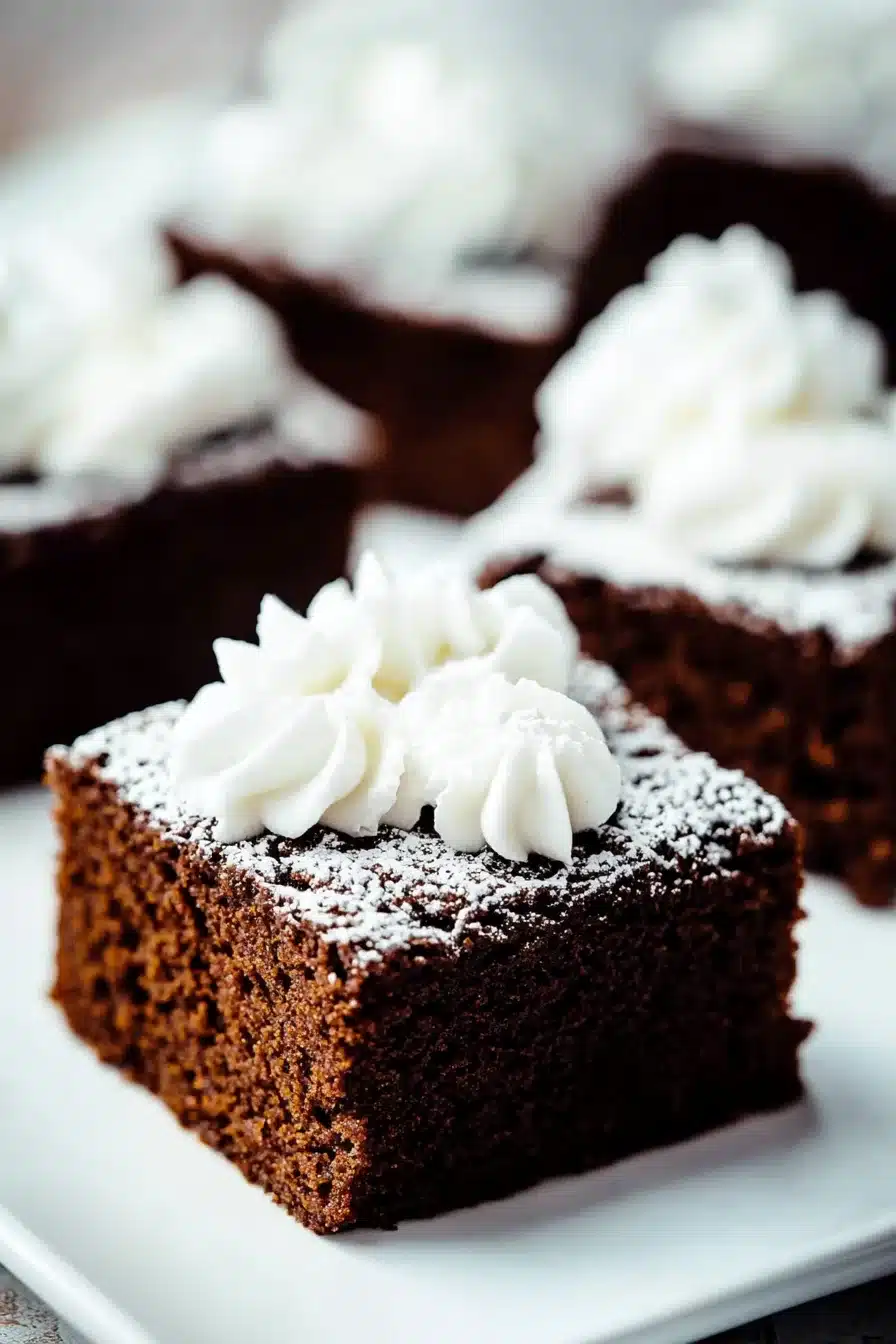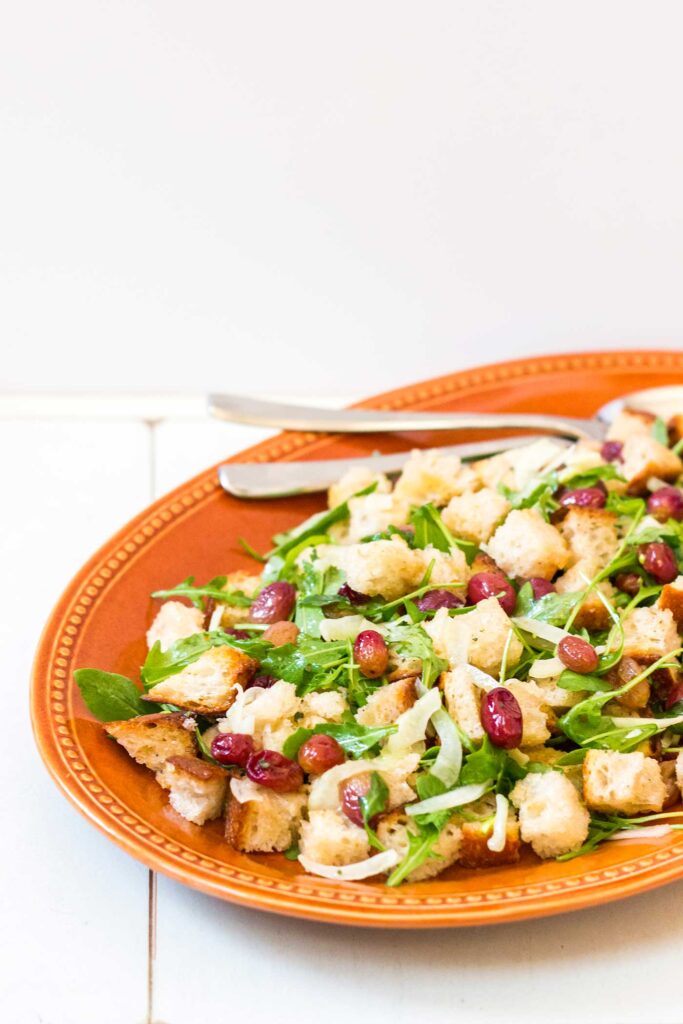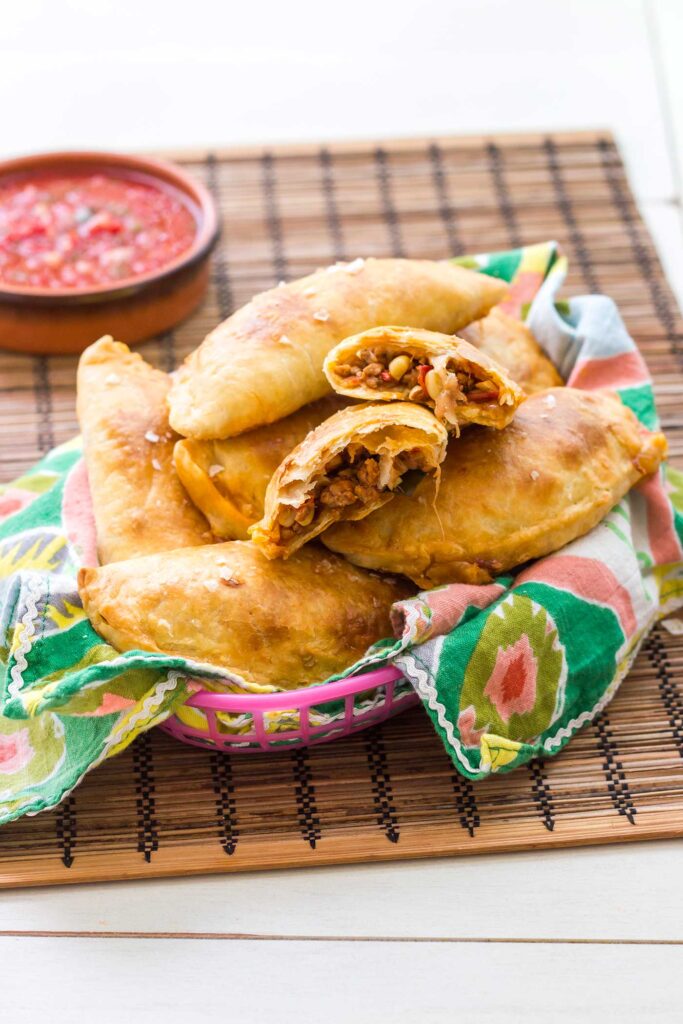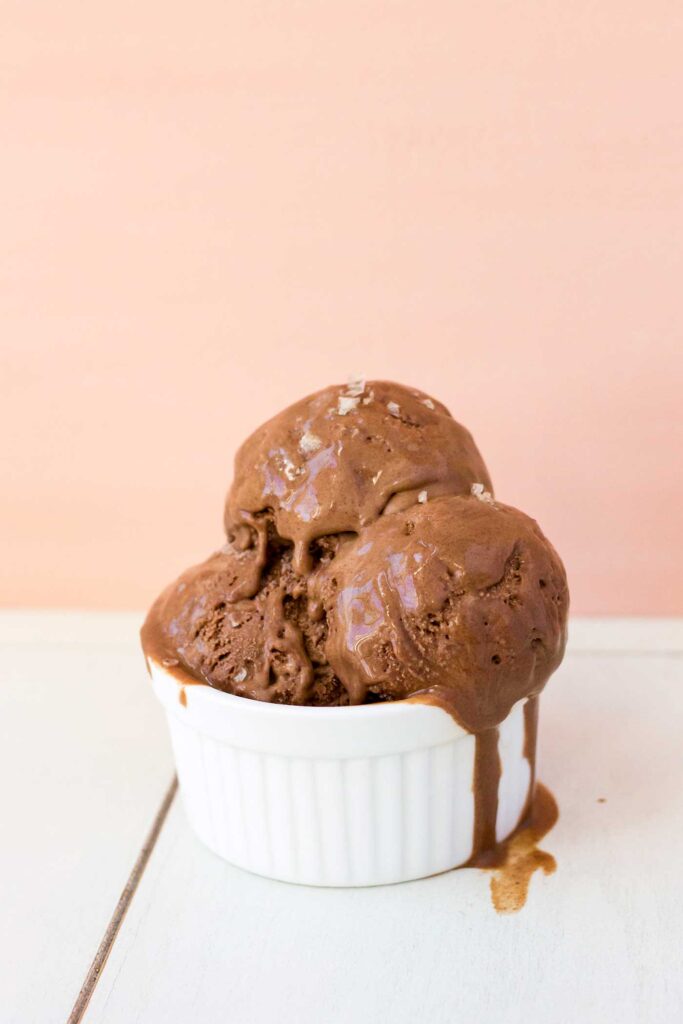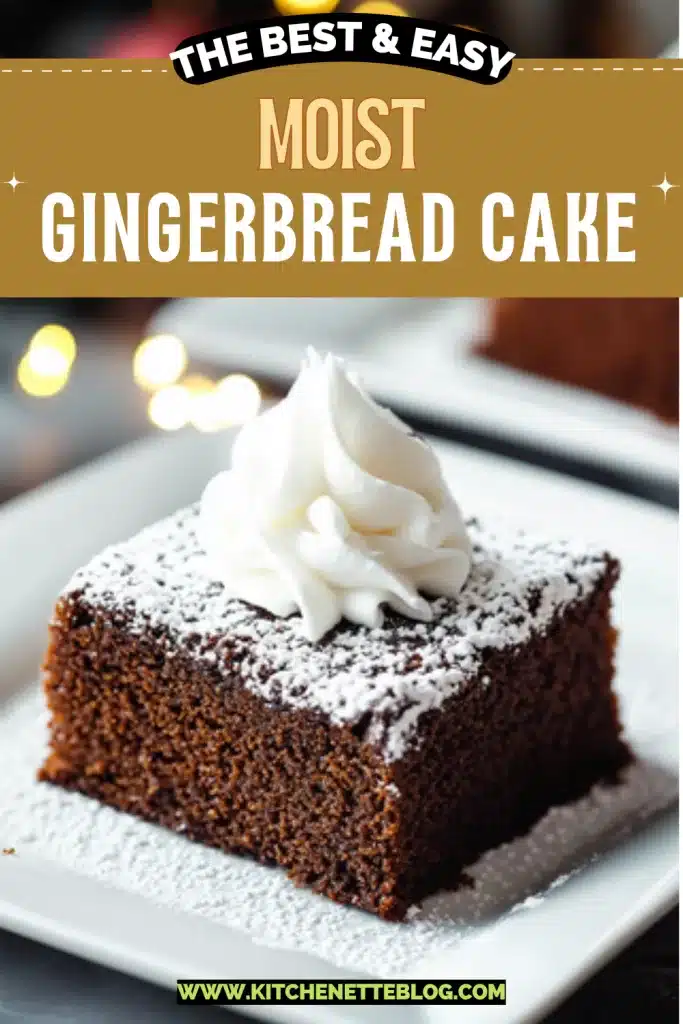
Sweetly spiced with dark brown sugar, buttery molasses, and warm ground ginger, this gingerbread cake smells like winter magic and tastes even cozier.
Creamy butter, a hint of cinnamon, and just enough nutmeg swirl into a tender, rich crumb that begs for whipped cream (or a little glaze, if you’re feeling fancy).
There’s something that happens when you mix molasses and spice into cake batter and slide it into a warm oven. The kitchen transforms. It smells like comfort. And curiosity. And maybe a tiny bit like nostalgia, even if gingerbread cake never graced your childhood—which, let’s be honest, it didn’t grace mine either. But now? It’s here, steaming gently on a wire rack, practically begging for a dusting of sugar snow.
This one isn’t dry or fussy. It’s plush. Moist (yes, I said it), gently sweet, not overly sticky. You can whip this up on a lazy Sunday, serve it on a chilly Tuesday night, or sneak forkfuls while standing over the sink—there’s no wrong way.
Table of Contents

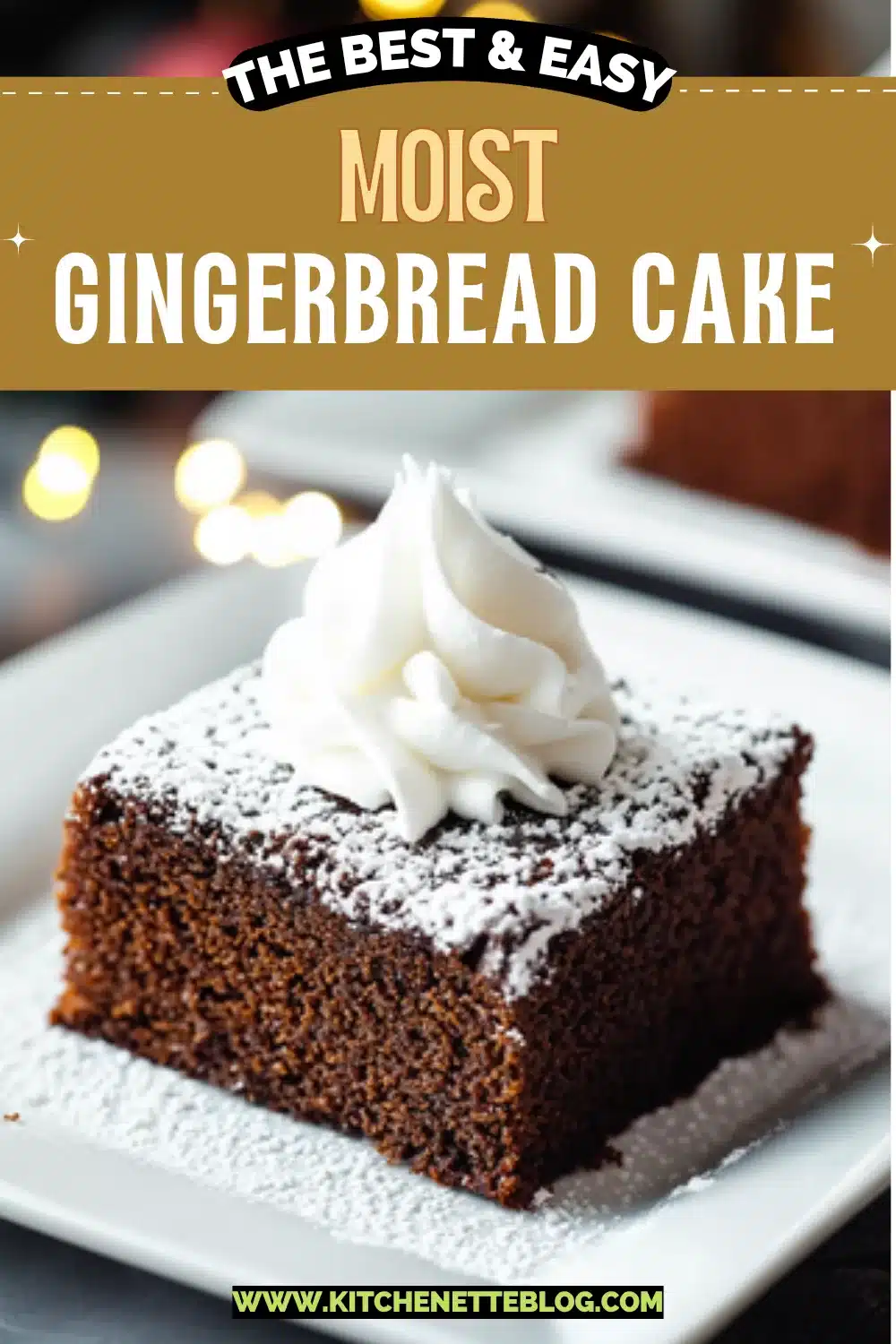

Don’t let this one slip away — pin it now and thank yourself later!
Don’t let this one slip away — pin it now and thank yourself later!
Why You’ll Love this Gingerbread Cake
Let’s not overcomplicate things—this is a simple, spice-kissed cake that leans into coziness with zero apology.
- Ridiculously simple to make: You just mix, pour, bake, and boom—your kitchen smells like a festive candle but better (and edible).
- Texture for days: The crumb stays soft and tender from the molasses and hot water combo—zero dryness, scout’s honor.
- Warm spice balance: It’s not one-note ginger; you get cloves, cinnamon, a whisper of nutmeg. Like a tiny spice committee made excellent choices.
- Flexible topping options: Dust it with powdered sugar, drizzle with vanilla glaze, or plop some whipped cream on top—she’s low-maintenance but stunning.
- Winter-perfect flavor: One bite and you’ll want flannel, fairy lights, and possibly a second piece.
- Make ahead friendly: Tastes even dreamier the next day, if it survives that long.
Ingredient Notes
You don’t need anything fancy, but each piece of the puzzle really pulls its weight here.
- All-purpose flour: Nothing special here, just your pantry MVP providing structure with a soft, fluffy crumb.
- Baking soda + baking powder: The classic leavening duo. Baking soda reacts with the molasses for lift, and the powder gives extra rise insurance.
- Salt: It won’t make the cake salty—just balanced. Without it, the spices fall flat.
- Ground ginger + other spices: Go for fresh-ish spices if you can. The ginger brings the heat, cinnamon adds warmth, and the cloves and nutmeg keep things cozy and complex.
- Unsalted butter: Softened butter makes creaming with sugar a breeze and gives the cake richness without making it greasy.
- Dark brown sugar: Adds a deep, caramel-like sweetness that plays beautifully with molasses.
- Egg: It holds everything together without turning the texture bready. Room temp is key.
- Unsulphured molasses: Don’t use blackstrap—it’s too bitter. Regular molasses gives that signature gingerbread color and flavor.
- Hot water (or coffee): Weirdly magical. The heat helps everything blend smoothly, and coffee deepens the spice notes without tasting like, well, coffee.
How To Make This Gingerbread Cake
Let’s bake. You don’t need special tools, just a little stirring, a spoon to taste the batter (who’s judging?), and a prepared pan.
-
Prep the oven and pan: Preheat to 350°F, then grease a 9-inch square baking pan and line it with parchment if you don’t want sticky sides later. I do this Grease+Line maneuver for almost all cakes. It just makes life easier.
-
Whisk dry ingredients: In a separate bowl, mix your flour, leaveners, spices, and salt. It’s a good way to evenly distribute the spices, so you don’t get one rogue clove-heavy bite.
-
Cream the butter and sugar: Use an electric mixer to beat the softened butter and dark brown sugar until light and fluffy. This usually takes at least 2–3 minutes, so don’t rush. It should look like delicious ginger sand.
-
Add egg and molasses: Crack that egg in and mix it up, then drizzle in your molasses and beat until smooth. The mixture will look glossy and dark and smell incredible already.
-
Alternate dry mix and hot liquid: Pour in the dry ingredients gradually, in three batches, alternating with hot water or coffee. Always start and end with dry. Mix just until combined (don’t beat it to death—it’s a cake, not whipped cream).
-
Bake: Pour the batter into your prepared pan, smoothing the top. Bake for 30–40 minutes—but start checking around 30. A toothpick should come out mostly clean, maybe with a few crumbs clinging.
-
Cool and serve: Let it hang out in the pan for about 10 minutes, then lift it onto a cooling rack. Once cool, dust with powdered sugar or pile on whipped cream. Maybe both.
Storage Options
So let’s say, against all odds, you don’t eat the entire gingerbread cake in one sitting. Here’s how to store it.
Wrap any leftovers tightly or stash pieces in an airtight container. At room temp, they’ll stay soft for 2–3 days. If your kitchen runs warm and gets humid, just pop it into the fridge. It’ll hang out happily for up to 5 days there.
To freeze, slice the cake into squares and wrap them individually. Then place those little spice parcels into a zip-top bag or freezer container. They’ll keep well for up to 2 months. Reheat straight from frozen in the microwave for about 30 seconds, or let thaw at room temp.
Warming it a little brings back the soft texture and makes it smell like you just baked it (magic). Bonus tip? Toast it lightly and add whipped cream for a faux gingerbread shortcake moment. Not traditional. Very tasty.
Variations and Substitutions
Want to make it your own? Here are a few swaps and twists that play nicely.
- Brewed coffee instead of water: If you didn’t try this version yet—do it! Coffee deepens the flavor without tasting “coffee-ish.” It’s subtle but wildly good.
- Olive oil instead of butter: You’ll get a slightly more rustic texture, a little more moisture, and it stays soft longer. Great if you’re skipping dairy.
- Add chopped crystallized ginger: Stir this into the batter for ginger-on-ginger action and chewy little surprises in every bite.
- Top with lemon glaze: Whisk powdered sugar with lemon juice for a zingy finish that cuts the richness.
- Use cake flour: If you prefer a lighter, almost spongy crumb, cake flour gives it a soft bakery-style vibe.
What to Serve with Gingerbread Cake
This cake plays well with others—and brings just enough spice to be the star without stealing the whole show.
-
A warm cup of black tea or holiday chai is dreamy here. The cake’s sweetness meets the tannic bite and the whole thing feels extremely cozy, like a knit sweater you can eat with.
-
A scoop of vanilla ice cream (melting slowly into a slice) turns this into dessert-dessert, especially if the cake is still warm. Little gingerbread lava vibe.
-
For a savory swing, I once paired a slice of this alongside a bowl of Pasta Fagioli on a snow day, and wow—spicy soup and spiced cake? A surprisingly lovely contrast.
-
Pair with breakfast if you dare. Seriously. Think thick coffee, a slab of butter on top, maybe next to some bacon cornbread muffins. It’s not health food, but it’s happy-making food.
-
A final curveball: try it with a drizzle of slightly tangy yogurt and some toasted nuts. It skews more sophisticated brunch and less straight-up dessert.
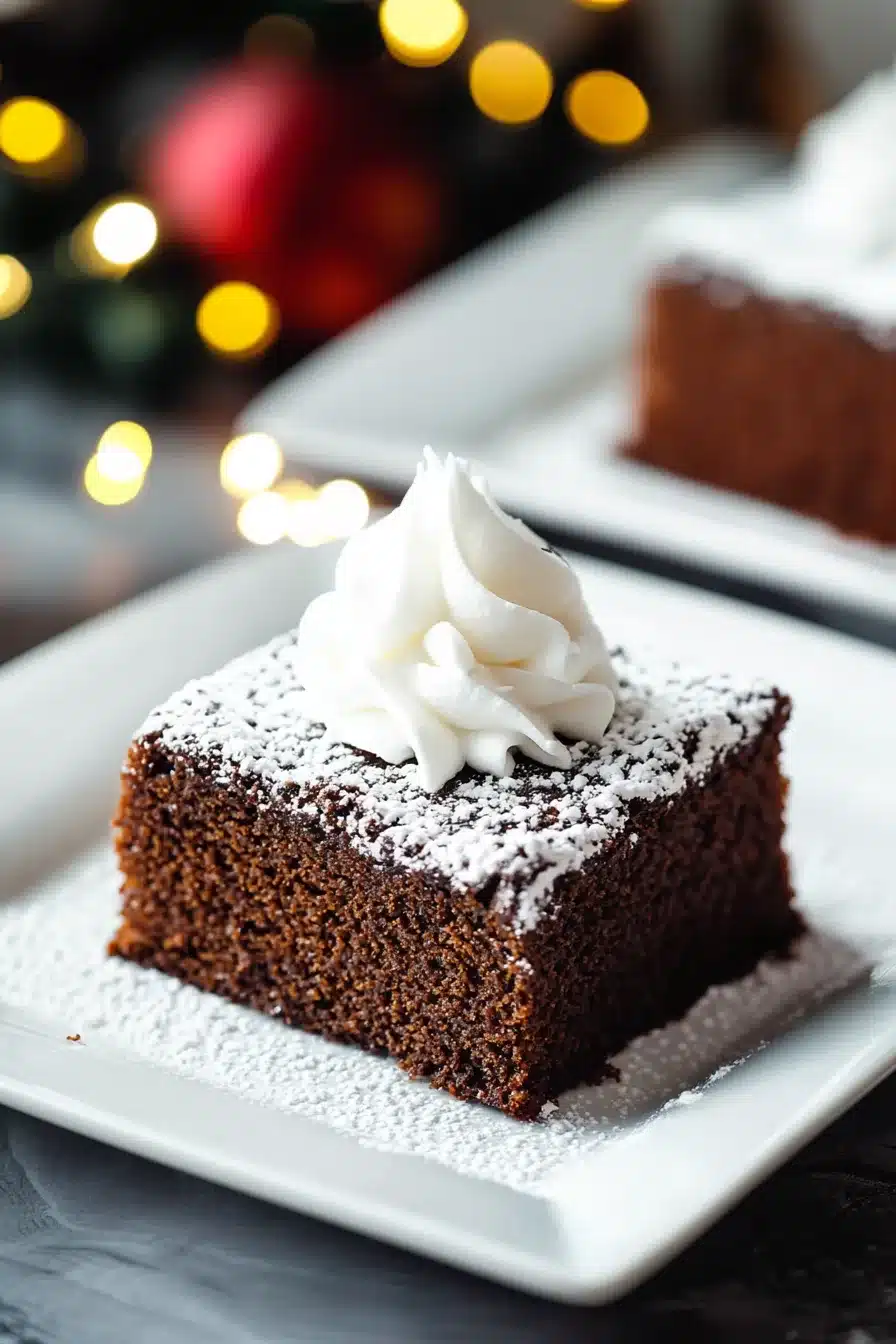

Don’t let this one slip away — pin it now and thank yourself later!
Don’t let this one slip away — pin it now and thank yourself later!
Frequently Asked Questions
Can I make this gingerbread cake ahead of time?
Yes, and honestly, the flavor gets even better on day two. You can bake it the night before, cool it completely, then cover tightly. The spices deepen overnight, and the crumb stays soft. Just hold off on any powdered sugar dusting until you’re ready to serve so it doesn’t melt in.
Can I use blackstrap molasses for this cake?
I really wouldn’t. Blackstrap molasses is intensely bitter and not the vibe we’re going for here. Stick to regular unsulphured molasses—it brings that dark, syrupy richness without turning the cake into a burned-spice experience.
What should I do if I don’t have ground cloves?
No worries. You can leave them out, or use a pinch of allspice instead. The cake will still taste great; cloves are strong, and a little goes a long way anyway. Don’t overdo the replacement—less is more with that spice family.
Why is my cake too dense or gummy?
This usually happens if the batter is overmixed or if it sits too long before baking. Once you add the flour, stir gently until just combined. Also, make sure the hot water or coffee is truly hot when added—it helps dissolve the molasses, which smooths everything out.
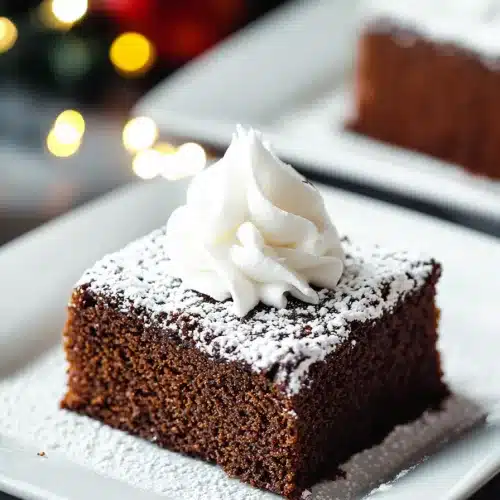
Moist Gingerbread Cake
Ingredients
- 2 cups (250 g) all-purpose flour spooned and leveled
- 1 tsp baking soda
- 1 tsp baking powder
- 1/2 tsp (0.5 tsp) salt
- 2 tsp ground ginger fresh if possible
- 1 tsp ground cinnamon
- 1/4 tsp (0.25 tsp) ground cloves or allspice
- 1/8 tsp (0.125 tsp) ground nutmeg
- 113 g (0.5 cup) unsalted butter softened (1/2 cup)
- 3/4 cup (150 g) dark brown sugar packed
- 1 large egg room temperature
- 1/2 cup (120 ml) unsulphured molasses not blackstrap
- 3/4 cup (180 ml) hot water or brewed coffee just off the boil
- powdered sugar or whipped cream for serving, optional
Equipment
- 9-inch square baking pan
- Mixing bowls
- Electric mixer
- Whisk
- Spatula
- Parchment paper
Instructions
- Preheat oven to 350°F (175°C). Grease a 9-inch square baking pan and line with parchment paper for easier removal.
- In a bowl, whisk together the flour, baking soda, baking powder, salt, ginger, cinnamon, cloves, and nutmeg until well combined. Set aside.
- In a large bowl, use an electric mixer to beat the softened butter and dark brown sugar until very light and fluffy, about 2–3 minutes.
- Add the egg and mix well. Drizzle in the molasses and beat until mixture is smooth and glossy.
- Alternate adding the dry ingredients and hot water (or coffee) to the butter mixture in three additions, starting and ending with the dry ingredients. Mix each addition just until incorporated—do not overmix.
- Pour batter into prepared pan and smooth the surface. Bake for 30–40 minutes, or until a toothpick inserted into the center comes out mostly clean with just a few moist crumbs.
- Let cake cool in the pan for about 10 minutes, then lift out and transfer to a wire rack to cool completely. Dust with powdered sugar or top with whipped cream, if desired, before serving.

